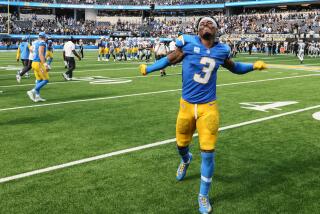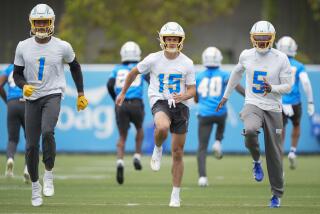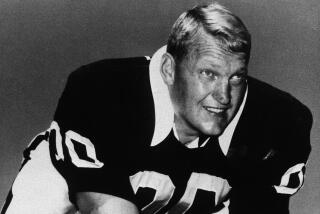Wrecking Ball : Raider Nose Guard a Bright Spot as the Newest Force in the Middle
- Share via
There’s no question that Raider nose guard Jerry Ball is a force in the middle. Just ask the offensive linemen around the NFL who have gone up against him over the last eight seasons.
“Jerry Ball is the man ,” New Orleans Saint guard Jim Dombrowski said. “When he gets in the middle, he’s a load to move.”
At 6 feet 1 and several late-night meals over his listed 300 pounds, Ball has been a pleasant surprise this season for the Raiders after signing as a free agent from the Cleveland Browns during the off-season.
“I’ve said all along that he’s a player,” Raider Coach Art Shell said. “He’s done everything we expected from him this season.”
After the retirement of Howie Long and the release of Greg Townsend, other players turned to Ball as a veteran leader of the Raiders’ defensive line. In their traditional 4-3 scheme, Ball began training camp as a reserve defensive tackle.
But once the season started, it did not take long for the Raiders to realize that Ball’s best role is as a starter creating havoc by lining up over opposing centers.
Ball can dominate an opponent’s rushing attack with quickness and strength. Since his arrival, the Raiders’ run defense has become the most improved area on the team.
Until the Pittsburgh Steelers ran for 175 yards last Sunday, the Raiders had the best run-stopping defense in the AFC, thanks to Ball and his fellow linemen, Chester McGlockton, Nolan Harrison and Anthony Smith.
“If you follow my career, you’d notice that wherever I played, no one ran up the middle,” Ball said. “I’ve always been the man in the middle. Even when I was playing in the Pro Bowl, I never had too many sacks. My specialty is stopping the run and making the people around me better.”
Ball, who will turn 30 in two weeks, is still relatively young for a defensive lineman. But word around the league last summer was that he was washed up.
After being the 63rd pick in the third round of the 1987 draft by Detroit, Ball was a three-time Pro Bowl player with the Lions. But he was sidelined because of a knee injury at the end of the 1991 season by a chop-block by New York Jet running back Brad Baxter.
At that time, Baxter’s block was legal. But the next year, the NFL instituted the so-called Jerry Ball Rule, which outlawed the type of block that had injured him.
Ball, who sat out the playoffs because of the injury, got off to slow start in 1992 and soon was labeled a clubhouse lawyer who no longer could dominate a game because he was overweight.
Before the start of the 1993 season, Ball was traded to Cleveland for a third-round draft choice.
“I know what really happened in Detroit, and it did not concern what I did on the field,” said Ball, a popular player who wrote a column for local newspapers during his career with the Lions. “In Detroit, I guess you can say that I was a little bit more involved in areas they really didn’t want players involved in.”
One person who did not care for Ball’s outspokenness was Chuck Schmidt, the club’s executive vice president who spearheaded the trade to Cleveland.
“My last year there, I was told by the coaches that I should just worry about playing,” Ball said. “So I just stepped aside and did my job and did what I was asked to do.”
Ball’s frustration with Detroit’s losing led him to join the Browns.
“I was tired of putting up with things that were not conducive for winning at Detroit,” he said. “I felt that I was being asked to sacrifice my body for an organization that did not have a clear agenda for winning. They didn’t really want to attack the problems and correct them.”
The Browns thought they had a steal with Ball as they teamed him with Pro Bowl defensive tackle Michael Dean Perry.
But problems with Cleveland surfaced at contract time. After helping the Browns to a 3-0 start, Ball had his agent, David Ware, approach the team for a contract extension before the midseason signing deadline since he was in the final year of his contract.
The Browns reportedly offered Ball a three-year deal worth about $1.6 million per year; Ball was asking for $2 million per year.
Once it became clear that Ball was not going to back down, the Browns began questioning his weight and work habits.
Once Perry signed a three-year deal worth about $3.16 million a year last December, Ball knew it was time to move on. That’s when the Raiders entered the picture.
Ball signed a one-year contract with the Raiders for much less than what he would have received from Cleveland because of championship potential.
“I was going to retire, but I made an investment in myself,” said Ball, who owns an NFL-licensed sportswear company. “My first conversation I had with (Shell), I took his hand and I told him to touch me and said, ‘I’m a big person. I’m not going to disappear, you understand? It’s not much more that I can do.’ And he told me, ‘Hey, you’re talking to a big guy. I understand.’ ”
In a disappointing season, Ball has been a Raider bright spot. In 12 games, he has 38 tackles and two sacks. He is tied among defensive linemen for the lead in pass deflections with four.
Is Ball surprised with his success this season?
“I understand economics and I understand this business probably better than 99% of the players in this league,” Ball said. “I know how to function in this system. I turned down a lot more money to stay with Cleveland. It wasn’t because of the dollar, it was because of principle.
“It’s only a surprise to people who buy into the things that are inconsistent with the truth. Those are the only people that are surprised. Jerry Ball the man is not surprised because I’m doing the same things that I did in Cleveland. I’m just a person who’s very comfortable with who he is.”
More to Read
Go beyond the scoreboard
Get the latest on L.A.'s teams in the daily Sports Report newsletter.
You may occasionally receive promotional content from the Los Angeles Times.










